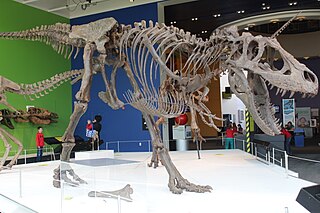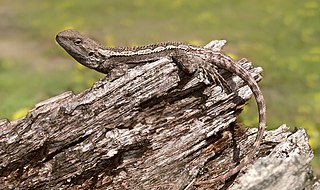
Daspletosaurus is a genus of tyrannosaurid dinosaur that lived in Laramidia between about 79.5 and 74 million years ago, during the Late Cretaceous Period. The genus Daspletosaurus contains two species. Fossils of the earlier type species, D. torosus, have been found in Alberta, while fossils of the later second species, D. horneri, have been found only in Montana. A possible third species, also from Alberta, awaits formal identification and another possible species D. degrootorum, also exists, but it may belong to the separate genus Thanatotheristes instead. Daspletosaurus is closely related to the much larger and more recent tyrannosaurid Tyrannosaurus rex. Like most tyrannosaurids, Daspletosaurus was a multi-tonne bipedal predator equipped with dozens of large, sharp teeth. Daspletosaurus had the small forelimbs typical of tyrannosaurids, although they were proportionately longer than in other genera.

Amphibolurus is a genus of lizards in the family Agamidae. The genus is endemic to Australia.

Lophognathus is a genus of large-bodied agamid lizards, consisting of two species — L. gilberti and L. horneri — both of which are endemic to northern Australia. Along with several other closely related genera, these lizards are commonly referred to as "dragons". In Australia, these lizards are also colloquially known as "Ta Ta" lizards, due to their habit of "waving" after running across hot surfaces.

John Robert Horner is an American paleontologist most famous for discovering and naming Maiasaura, providing the first clear evidence that some dinosaurs cared for their young. In addition to his paleontological discoveries, Horner served as the technical advisor for all the Jurassic Park films, had a cameo appearance in Jurassic World, and served as a partial inspiration for one of the lead characters of the franchise, Dr. Alan Grant. Horner studied at the University of Montana, although he did not complete his degree due to undiagnosed dyslexia, and was awarded a Doctorate in Science honoris causa. He retired from Montana State University on July 1, 2016 although he claims to have been pushed out of the Museum of the Rockies after having married an undergraduate student and now teaches as a Presidential Fellow at Chapman University.

Achelousaurus is a genus of centrosaurine ceratopsid dinosaur that lived during the Late Cretaceous Period of what is now North America, about 74.2 million years ago. The first fossils of Achelousaurus were collected in Montana in 1987, by a team led by Jack Horner, with more finds made in 1989. In 1994, Achelousaurus horneri was described and named by Scott D. Sampson; the generic name means "Achelous lizard", in reference to the Greek deity Achelous, and the specific name refers to Horner. The genus is known from a few specimens consisting mainly of skull material from individuals, ranging from juveniles to adults.

Tyrannosauroidea is a superfamily of coelurosaurian theropod dinosaurs that includes the family Tyrannosauridae as well as more basal relatives. Tyrannosauroids lived on the Laurasian supercontinent beginning in the Jurassic Period. By the end of the Cretaceous Period, tyrannosauroids were the dominant large predators in the Northern Hemisphere, culminating in the gigantic Tyrannosaurus. Fossils of tyrannosauroids have been recovered on what are now the continents of North America, Europe and Asia, with fragmentary remains possibly attributable to tyrannosaurs also known from South America and Australia.

Anasazisaurus is a genus of saurolophine hadrosaurid ("duckbill") ornithopod dinosaur that lived about 74 million years ago, in the Late Cretaceous Period. It was found in the Farmington Member of the Kirtland Formation, in the San Juan Basin of New Mexico, United States. Only a partial skull has been found to date. It was first described as a specimen of Kritosaurus by Jack Horner, and has been intertwined with Kritosaurus since its description. It is known for its short nasal crest, which stuck out above and between its eyes for a short distance.

Thecospondylus is a dubious genus of dinosaur from the Early Cretaceous of England. Scientists are unsure as to whether Thecospondylus was a saurischian or an ornithischian.

Weber's sailfin lizard, is a species of lizard in the family Agamidae. The species is endemic to Indonesia.
Trachyrhinus is a genus of harvestmen in the family Sclerosomatidae from North America.
Mescalerolemur is an extinct genus of adapiform strepsirrhine from late Middle Eocene deposits of Brewster County, Texas. It is known from the holotype TMM 41672-232, associated left and right maxillae with partial and complete teeth and from the referred specimens TMM 41672-230, TMM 41672-233 and TMM 41672-236. It was found from the Purple Bench locality of the Devil's Graveyard Formation, Big Bend region. It was first named by E. Christopher Kirk and Blythe A. Williams in 2011 and the type species is Mescalerolemur horneri. Its closest relative is Mahgarita from the same formation but slightly younger in age.

Oohkotokia is a genus of ankylosaurid dinosaur within the subfamily Ankylosaurinae. It is known from the upper levels of the Two Medicine Formation of Montana, United States. The discovery of Oohkotokia supports that Ankylosaurine dinosaurs existed and flourished continuously in Montana and/or Alberta throughout the late Campanian and early Maastrichtian stages in the Late Cretaceous period. It was a large, heavily built, quadrupedal, herbivore, that could grow up to 6 m (19.7 ft) long.
Sargassum horneri is a species of brown macroalgae that is common along the coast of Japan and Korea. It is an annual algae which has a varying fertile season along the coast. In Wakasa Bay it began to grow in early autumn through winter, becoming matured in Spring, when the sea water temperature was 11.6–15.2 °C (53–59 °F) in average. Also called "devil weed", this species has invaded the Eastern Pacific, beginning in Baja California and advancing north along the California coastline.
Strophurus horneri, also known commonly as the Arnhem phasmid gecko, is a species of lizard in the family Diplodactylidae. The species is endemic to Australia.

Gowidon is a genus of arboreal lizards in the family Agamidae. It is monotypic with a single recognised species, Gowidon longirostris, commonly known as the long-snouted lashtail or long-nosed water dragon. It is found in Northern Territory, Queensland, South Australia, Western Australia, Australia, and in New Guinea.
Thanatotheristes is a genus of tyrannosaurid dinosaur from the Late Cretaceous of Laramidia, approximately 80.1-79.5 Ma. Thanatotheristes contains only one species, T. degrootorum. Fossils of this taxon are found in the Foremost Formation of Alberta, Canada, coexisting with medium-sized ceratopsids like Xenoceratops foremostensis and small pachycephalosaurids like Colepiocephale lambei.

Lophognathus gilberti, Gilbert's lashtail or Gilbert's dragon, is a species of agama found in Australia.

Lophognathus maculilabris is a species of agama found in Indonesia.

Flustra is a genus of bryozoans belonging to the family Flustridae. The genus has a cosmopolitan distribution.














